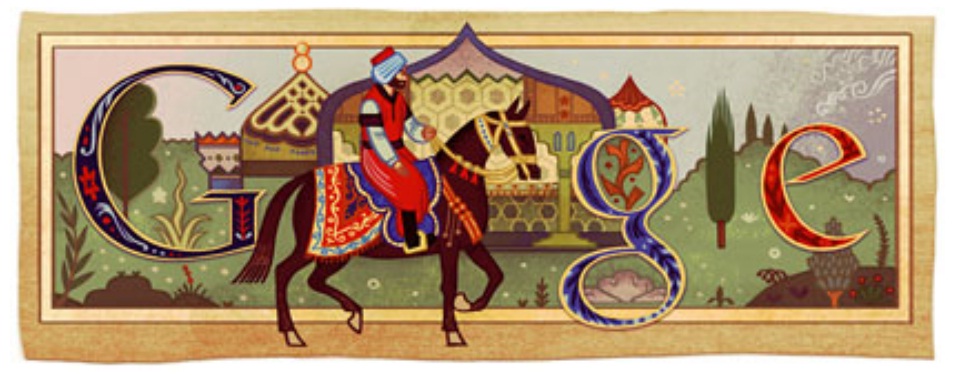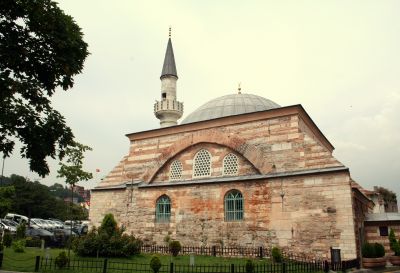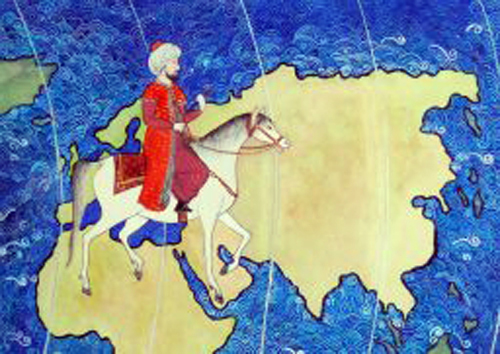(1).jpg)
THE TRAVELER OF THE WORLD AND COMPANION OF MANKIND, EVLIYA ÇELEBI, IS OVER 400 YEARS OLD
If one were to list the ten most famous names in Ottoman history, there is no doubt that Evliya Çelebi would be among them. Evliya Çelebi engraved his name in history in golden letters thanks to both his brilliant personality and his unparalleled work, the Seyahatname (Book of Travels).
UNESCO declared 2011, the 400th anniversary of the famous traveler’s birth, the Year of Evliya Çelebi. On this occasion, Scottish historian Caroline Finkel began filming a documentary by traveling the mountains and plains that Evliya Çelebi once journeyed through.

Evliya Çelebi's family was originally from Kütahya. When he was born in Unkapanı in 1611, his father, Kuyumcubaşı (Chief Goldsmith) Derviş Mehmed Zilli, was 105 years old. He lived for 142 years. It appears that the vigor Evliya Çelebi needed to undertake such arduous journeys in that era was inherited from his father. His great-grandfather was Yavuzer Sinan, who, in disguise, did not recognize Sultan Mehmed II and refused him entry through the city walls for not knowing the password—he was therefore praised with the words "You are a stern man (Turkish: yavuz er)!" His lineage thus extends back to Ahmed Yesevi. Out of respect for the great imam of the time, Evliya Mehmed Efendi, his father gave him the name Evliya (awliya, a spiritually enlightened person). His mother was an Abkhazian girl related to Grand Vizier Damad Melek Ahmed Pasha.
Travel, O Messenger of Allah!
He was trained at the Palace School (Enderun). With his sweet voice and handsome face, he attracted the attention of Sultan Murad IV. He became the Sultan’s muezzin and companion. His father’s delightful conversations, which dated back to the time of Sultan Suleiman I, inspired in him a desire to travel. One Ashura night, he saw the Prophet Muhammad in a dream at the Ahi Çelebi Mosque in Eminönü among a large congregation. As he approached the Prophet, instead of saying “Intercession (shafaat), O Messenger of Allah!” he excitedly blurted out “Travel (sayahat), O Messenger of Allah!” Upon this, the Prophet smiled and not only gave him the glad tidings of intercession but also granted him permission to travel. Sa’d ibn Abi Waqqas, who was present in that gathering, advised him to write down what he saw. Upon waking, his first task was to recount his dream to Abdullah Dede, the sheikh of the Kasımpaşa Mevlevi Lodge. Abdullah Dede interpreted the dream and advised him to “Begin by recording our dear Istanbul.” As a result of his initial explorations of Istanbul, Evliya Çelebi wrote the first volume of the Seyahatname, which can be considered a standalone history of Istanbul.
Despite his father’s opposition, at the age of 29, he embarked on his first journey to Bursa. He then went to Trabzon and Crimea. He participated in the Cretan campaign. As the muezzin and confidant of Defterdarzade Mehmed Pasha, he went to Erzurum. He traveled through most of Anatolia and reached as far as Tbilisi and Baku. He joined the Azerbaijan and Georgia campaign. He went to Syria with Mustafa Pasha, the governor of Damascus. When Melek Ahmed Pasha became Grand Vizier in 1650, he began traveling with him. He extensively toured Rumelia. As part of an embassy, he went as far as Vienna. He traveled through Europe. In 1671, he went on pilgrimage (Hajj). He stayed in Mecca for 8–9 years. He said, “I took part in 22 battles, traveled for 50 years.”

A Tombstone in Every Place
Years of traveling on horseback, playing jereed (a traditional Turkish equestrian game), and skillful use of weapons granted him agility and health. He never married. He came from a wealthy family. He held official posts that allowed him to travel. He gained wealth from war spoils, gifts he received, and trade he conducted in the places he visited. He likely died in 1682. His grave was in the family cemetery next to the Meyyitzade mausoleum in Şişhane. During the single-party era (referring to early Republican Türkiye), it was removed under the pretext of road construction. The tombstones were buried in a pit. However, due to his humorous nature, he had tombstones engraved and erected in his name in places he visited.
Despite having friendships with sultans and state officials, Evliya Çelebi never became ambitious for office. He spent his life traveling, meeting new people, and discovering new lands. In his Seyahatname, he introduced himself as “The Traveler of the World and Companion of Mankind.” Truly, he won the hearts of people wherever he went with his cheerful demeanor and sweet tongue. He knew how to adapt to his audience, was agreeable to others, and was as clever as he was carefree. The famous traveler, who managed the difficult task of getting along well with everyone he accompanied, became the joy of gatherings and was sought after everywhere. He was handsome and charming. Despite all this, he faced many dangers, but managed to escape each time. It should also be remembered that he was a brave swordsman and a skilled archer who participated in many battles.
.jpg)
An Immortal Work
Evliya Çelebi observed the places and events he saw with great care, tried to understand the history of the places and the causes of events, and conveyed what he learned in a lively and curious style. To avoid leaving his Seyahatname incomplete, he wrote about places and events he did not personally witness as if he had, based on what he learned from others or old books. It is a tradition among Eastern historians to record all kinds of accounts without subjecting them to critical scrutiny. Thus, all kinds of material are collected. For this reason, contradictions can sometimes be seen in the Seyahatname. There are delightful exaggerations, such as a girl giving birth to an elephant in Van, a cat freezing to death while jumping from roof to roof in Erzurum, or a horse sent as a gift from the sultan to the emperor of Vienna dying of sadness after seeing the men in hats (Europeans) surrounding it.
Our traveler was so interested in the origins of words that he sometimes made humorous comparisons about city names. For example, he said Ankara was named so because its fortress was built through forced labor (angarya). Stories like the trial of the architect whose hand was cut off by Sultan Mehmed II (borrowed from ancient Persian mythology), or the fountain in Muş with an inscription cursing the Kurds, should be evaluated with caution. Especially the figure of Hezarfen Ahmed Çelebi—despite the importance of Ottoman historians and archives, who wrote down everything in the finest detail—was never mentioned by Evliya Çelebi, which gives the impression that he was a fictional character, though he came to be accepted everywhere without rational assessment.
The immortal Seyahatname, which he left behind as a vast treasure in the fields of history and geography for future generations, is like a colorful album of that era, ranging from marketplaces to battlefields. The original consists of 10 volumes. There are five different manuscript copies in Istanbul. The inconsistency in its spelling stems from the fact that it was written according to the dialect of each region. In this respect, it constitutes a rich source of dialectal material.

Önceki Yazılar
-
WHO CAN FORGIVE THE KILLER?31.12.2025
-
WHEN WAS PROPHET ISA (JESUS) BORN?24.12.2025
-
IF SULTAN MEHMED II HE HAD CONQUERED ROME…17.12.2025
-
VIENNA NEVER FORGOT THE TURKS10.12.2025
-
THE FIRST UNIVERSITY IN THE WORLD WAS FOUNDED BY MUSLIMS3.12.2025
-
WHO BETRAYED PROPHET ISA (JESUS)?26.11.2025
-
IT HAS BEEN MORE THAN 100 YEARS SINCE ITS ABOLITION, BUT... IS THE CALIPHATE BEING REESTABLISHED?19.11.2025
-
GREETINGS TO YOU, O OTTOMAN SANJAK!…12.11.2025
-
ROTHSCHILDS BROUGHT THE END OF THE OTTOMAN EMPIRE!5.11.2025
-
SHEIKH BEDREDDIN, SON OF THE QADI OF SIMAVNA29.10.2025